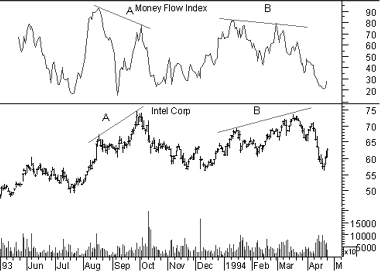|
MONEY FLOW INDEX
Overview
The Money Flow Index ("MFI") is a momentum indicator that measures the strength of money
flowing in and out of a security. It is related to the
Relative Strength Index, but where the RSI only incorporates prices,
the Money Flow Index accounts for volume.
Interpretation
The interpretation of the Money Flow Index is as follows:
Look for divergence between the
indicator and the price action. If the price trends higher and the MFI trends lower
(or vice versa), a reversal may be imminent.
Look for market tops to occur when the MFI is above 80. Look for market bottoms to
occur when the MFI is below 20.
Example
The following chart shows Intel and its 14-day
Money Flow Index.
 Divergences at points "A" and "B" provided leading indications of the
reversals that followed.
Divergences at points "A" and "B" provided leading indications of the
reversals that followed.
Calculation
The Money Flow Index requires a series of calculations. First, the period's Typical Price
is calculated.

Next, Money Flow (not the Money Flow Index) is calculated by multiplying the period's
Typical Price by the volume.

If today's Typical Price is greater than yesterday's Typical Price, it is considered
Positive Money Flow. If today's price is less, it is considered Negative Money Flow.
Positive Money Flow is the sum of the Positive Money over the specified number of
periods. Negative Money Flow is the sum of the Negative Money over the specified number of
periods.
The Money Ratio is then calculated by dividing the Positive Money Flow by the Negative
Money Flow.

Finally, the Money Flow Index is calculated using the Money Ratio.
|

